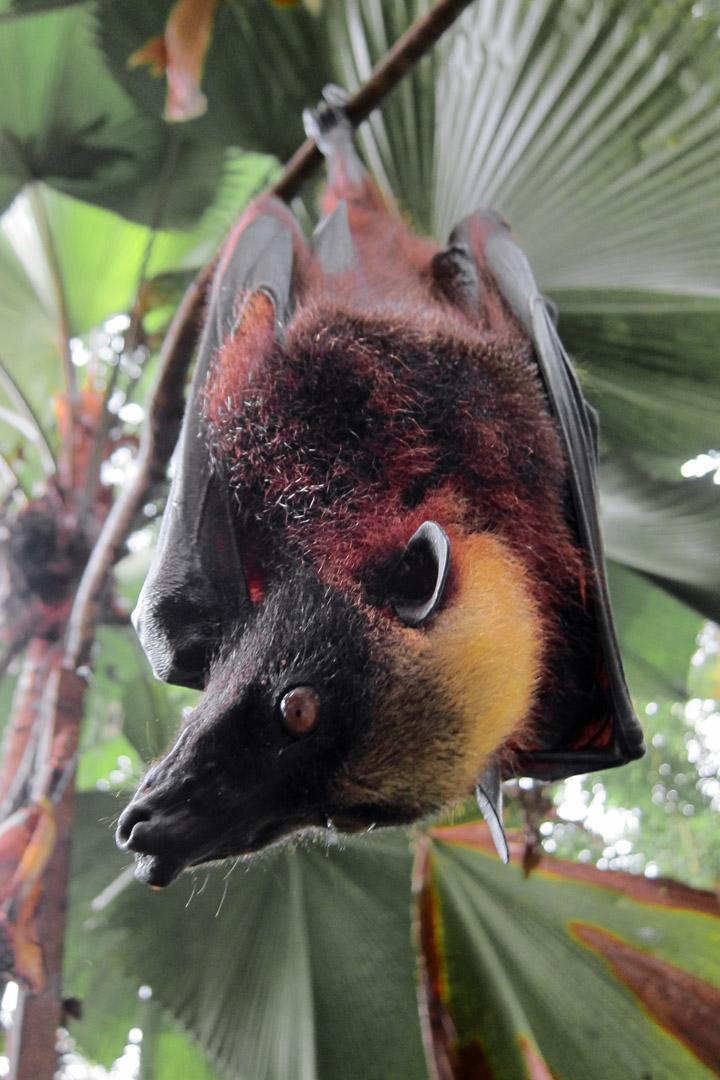
The giant golden-crowned flying fox (Acerodon jubatus), also known as the golden-capped fruit bat, is a rare megabat and one of the largest bats in the world. The species is endangered and is currently facing the possibility of extinction because of poaching and forest destruction. It is endemic to forests in the Philippines.
Description
The giant golden-crowned flying fox gets its species name from the golden fur around the head, in sharp contrast to the black body. Like all other fruit bats, they have no tail. They are among the largest bats, with a wingspan of 1.5–1.7 m (4 ft 10 in–5 ft 7 in) and weighing 0.7–1.2 kg (1.5–2.6 lb). The only other bats with comparable measurements are a few species of Pteropus.
Range
Recent surveys have found A. jubatus roosting with P. vampyrus on the islands of Bohol, Boracay, Cebu, Leyte, Luzon, Mindanao, Mindoro, Negros and Polillo.
Habitat
The giant golden-crowned flying fox is confined to the forests of the Philippines, where it occurs mostly at elevations from sea level to 1,100 m (3,600 ft). It prefers uninhabited areas. A 2005 study found none in inhabited areas. The same study also revealed that these bats use river corridors more than originally thought, because the fig trees located near rivers are the bats' main source of food. They do like to be close to agricultural fields but only in undisturbed forest areas.
In another study, it was shown that this species is a forest-obligate species, staying in the forest a majority of the time. Since this is a forest-obligate species, conservation will require the preservation of forest areas. Human encroachment on the bat's habitat in forest and lowland areas is a major factor in the species endangered conservation status.
Behavior
The giant golden-crowned flying fox is primarily nocturnal, and can travel at least 40 km (25 mi) in one night searching for food. This bat is a pollinator and seed disperser for many fruit trees in the Philippines. It uses water for grooming.
Diet
They eat primarily figs, though will take other fruit if figs are unavailable. They have been reported to eat cultivated fruit, but this is relatively rare. Other fruits that may be eaten include: puhutan, lamio, tangisang, bayawak, bankal and strangler figs. Known as "the silent planter," they release seeds in their droppings, often while flying. This helps maintain the Philippine rainforest.
Reproduction
Little is known about their reproduction. They appear to have two breeding seasons, but females only become pregnant during one of them. They typically give birth to only one pup. Females reach sexual maturity at two years.
Colonies
When fruit bats were abundant in the Philippines, the giant golden-crowned flying fox and the large flying fox (Pteropus vampyrus) would make colonies, reportedly numbering over 150,000 individuals. It is this roosting behavior that made them so easy to hunt, but also helps them keep warm and avoid natural predators.
Conservation
The giant golden-crowned flying fox is under threat from deforestation and has completely disappeared from many smaller islands and some larger islands, such as Panay and most of Cebu. The extinct Panay population was once considered a separate species, the Panay giant fruit bat (Acerodon lucifer), but is now included under Acerodon jubatus. They are also commercially hunted for meat in some areas.
Little is known about this species which makes it hard to manage, but since it is in decline, conservation attempts are underway. The local government of Maitum, Sarangani in the Philippines has organized a campaign to save the species from extinction. The Subic Bay region of the Philippines plays host to a lot of the research on this species. Subic Bay is a 14,000-acre (57 km2) protection area that is managed by individuals who want to preserve the species.
Agencies promoting the conservation of this species include Bat Conservation International, the Wildlife Conservation Society, the World Wildlife fund, Lubee Foundation and others. They provide research funding and education worldwide as well as locally.
The IUCN states that there is currently a captive breeding program underway.










